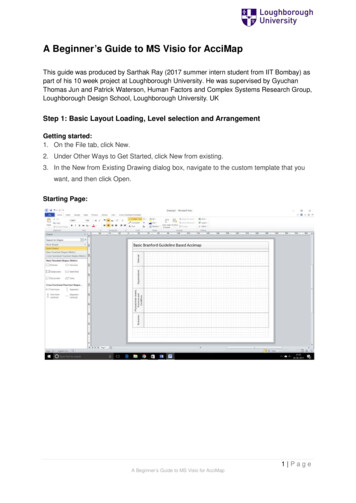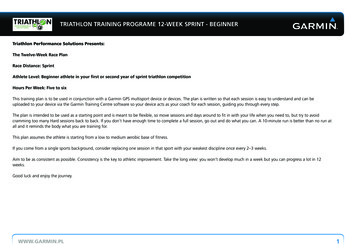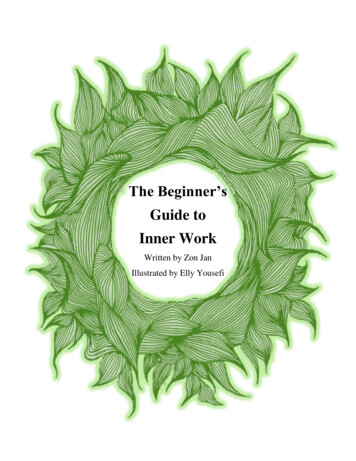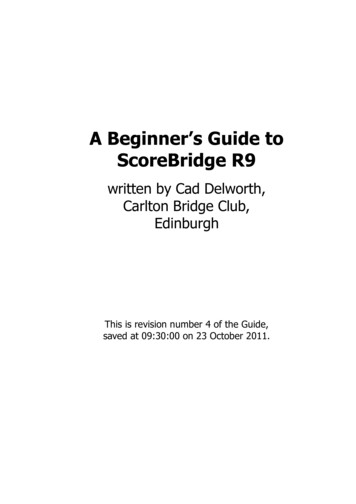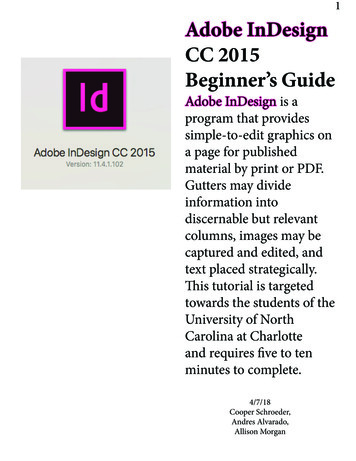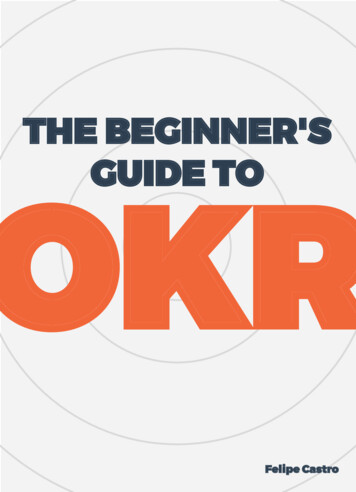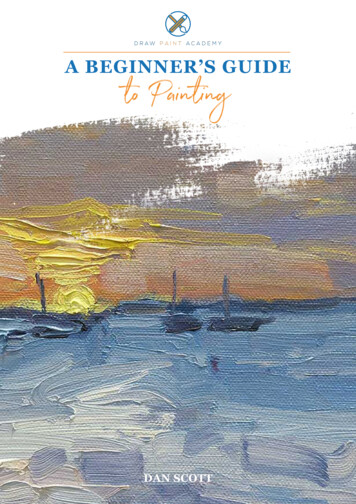
Transcription
A BEGINNER’S GUIDEto PaintingDAN SCOTT
IntroductionI remember that lost and confused feeling I had when I was learning how to paintmany years ago. I felt bombarded by information yet completely lost for direction. Ifyou are just starting out in painting, then chances are you feel this way too.What I needed was not a big ask or anything overly complex. I just needed a bit ofdirection and answers to some of the really basic questions which you are confrontedby when you start painting.I wrote this guide to give help beginners avoid this confusion and get a sense of direction with where they want to go in art and how they are going to get there. If you haveany questions or just want to chat, feel free to email me atdan@drawpaintacademy.com.2
Why Do You Want To Take UpPaintingBefore we get into the technical side of painting, I want you to consider the reasonswhy you want to take up painting in the first place and the reality of being an artist.This is important as many people get frustrated when they take up painting and sadlyquit way too early.Some of the common reasons people get frustrated in painting are: They do not realize just how hard painting is (the professionals certainly makeit look easy); They are not able to handle making mistakes (you will make mistakes when youare starting out and even once you are a master); They do not understand the processes and techniques; They are overwhelmed by a mass of information with no real direction; They do not sell any paintings;. and you get the point.The truth is, painting is an extremely challenging, but equally rewarding craft. Thereis a reason why our society holds the great artists in such high regard.Our society is willing to pay substantially for great paintings, which when you thinkabout it are nothing more than colored pigments arranged on a flat surface. Thesepaintings do not produce any direct wealth or fix any world problems. Despite this,they are held in our most prestigious buildings and gifted to our leaders.This is because painting is hard! But don’t let that discourage you. You should beproud that you are taking on such a highly revered craft.Once you understand why you are painting and the reality of being an artist, you willbe much more resilient to any challenges you face (and less likely to quit).With that being said, you may not be suited to painting. Not because you are unable tolearn. You may just realize it is not for you.But that is fine. There are many other artistic avenues you could pursue. For example,3
perhaps you do not like the hands-on approach of painting but enjoy composing landscape scenes. You may be better suited to photography in this case.TheWrong Reasons To Take Up PaintingHere are some of the wrong reasons to take up painting: You want to get rich. Money is important, but ifyour only goal is to make money from your art, thenyou should go into another avenue which has moresecure profits. That is not to say you are unable tomake money from your art. It is just very unpredictable. My thoughts on money and art are this do whatever you can to make enough money to livecomfortably and practice your art. If you are able tolive comfortably as an artist, then great. If you workfull-time and use that money to finance your art, thenthat is great also. If you like painting landscapes butthe market is only demanding portraits, then maybepaint portraits to make ends meet whilst practicinglandscape painting on the side. You want fame. This is much the same as the pointabove. Fame in art usually comes to those least expecting it. It is unpredictable by nature. Just look atVincent van Gogh, one of the most famous artists inhistory. He had no idea of his own fame as it all happened after his death. He was relatively unknownduring his lifetime. I wonder if he would be happy orsad about his postmortem fame? You want to become a master in a short period of time. It is great to have high expectationsof yourself, but painting is one of the most difficultcrafts to master. Many of the all-time masters ofpainting have said how little they knew even in theirlater years. Painting is easy to pick up, but extremelydifficult to master.Vincent van Gogh, Self PortraitAs An Artist, 18884
So if you are still reading, then you may still be interested in painting, which is great!I am not trying to be negative, just realistic. Painting can take up a significant amountof time and if you are not doing it for the right reasons, then you may as well saveyourself the effort.TheRight Reasons To Take Up PaintingNow for some of the right reasons to take up painting: You want to challenge yourself. Painting is hard, but anyone can take it up.All you need are some basic materials and you are good to go. You want a fulfilling hobby. Not everyone has aspirations to become a professional artist. Many are just looking for a fulfilling hobby. Painting is fantasticfor this. You can paint at pretty much any age, at any time of the day and at anyskill level. You seek an escape from your ever busy lifestyle. During my time as anaccountant, I was drawn in many different directions from conflicting interests.My days were fast-paced and often stressful. My decisions were influenced bymoney, politics and social standings. Painting is a great way to break away fromthis environment. There are no hidden biases with painting. You like the idea of creating something. Painting is one of the rare practices where the result is something truly unique and personal. Sure, there maybe other paintings very similar to yours, but none will be exactly the same. Yourstrokes and color selections are unique to you. You like to document your life. Paintings can represent a visual diary ofyour life. You can paint different experiences, places you visit, people you meetand emotions you feel. Since I started painting many years ago, I have built upa sizable body of paintings. All of them tell a story about a particular point inmy life. You want to work for yourself. If you want to become a professional artist,then you can treat your art career as if it were your own business. A major positive to this is you get to be your own boss.5
You want to empower your mind. The mind is powerful, much more powerful than the body. Painting is one of the best ways to challenge and empoweryour mind.If you are not sure about if painting is for you, then hopefully these reasons give youan idea of what you can expect to get out of it.Write It Down!I suggest you take a moment to actually write down why exactly you want to take uppainting. Keep this note safe, as you may find it to be an important reference laterdown the track.6
The Myth You Need “Natural Talent” To BecomeA Great PainterThe term “natural talent” gets thrown around a lot in art. Generally, it seems to beused as an excuse not to take up painting.Painting is no different to any other craft, sport or hobby. You learn, make mistakes,analyze where you went wrong and (hopefully) improve. People are not born with thenatural gift of painting, though obviously some pick it up faster than others.All the great masters of painting were amateurs at some stage. Here is the extremelysecret step by step blueprint for becoming a great painter: Learn the basics (what we will be doing throughout this guide)PracticeMake mistakes (yes mistakes are good, as you need them to learn and progress)Analyze your mistakesMake adjustmentsPracticeRepeat steps 2-6 over and overMasteryI consider painting to be technical craft which can be learned just like anything else.Sadly many painters hamper their progression by spending time trying to unlock somemysterious inner creative spirit rather than taking a structured and methodical learning approach. Sure, the structured learning approach may not sound as interesting,but it is a surefire way of becoming a great painter in time.Of course, there are some artists who hit it big in the commercial world without anyconsideration to learning the fundamentals of art. But you should not be striving tomimic them.My goal is to help you become a skilled artist, not a commercial success (though theycan go hand-in-hand).The way I learned painting is similar to how I learned many other things in life - accounting, volleyball, jujitsu, weightlifting, running and so on. I generally try and breakthe learning process into the following categories:7
Theory & Research - Learning the fundamentals of art, researching art history andfamous artists, watching other artists in practice and reading instructional books.Practice - Putting what I have learned from above into practice. Each session shouldhave some focus in mind (for example, I may want to learn more about color temperature, so I would paint a scene with contrasting warm and cool colors and observe therelationship).Reflective - This is often overlooked but is just as important, if not more, than theother learning areas. This involves reflecting on the work you have done and determining how you will improve. This is more of a passive process and could be as simpleas thinking about how you could improve your painting just before you go to sleep.Before I start a painting I always do a mental run-through of the painting process (thestrokes I will make, the colors I will use, the challenges I may face, etc). This makesthe actual painting process much smoother.I try to apply this way of learning to everything I do in art. It helps me actually improve rather than just churning through paint to no aim.So if your only reason for not painting is because you do not think you have the natural born talent to do so, then you best pick up your paint brush because that is not areason. Painting is hard I assure you, but everyone is capable of learning it (with someguidance of course).8
Acrylics, OilsOr Watercolors?One of the first questions you are faced with when you start painting is what mediumyou should focus on. The three main choices are acrylics, oils and watercolors.There is no correct answer to this and all three mediums have different characteristicswhich may or may not suit you. I personally use oils and I strongly recommend allstudents use oils also for reasons I discuss later in this article. But if you want to useother mediums, that is fine also.Acrylic Paint - The Beginner’s ChoiceNoosa - one of my acrylic paintings from when I was learning.Acrylics are widely favored by those just starting out with painting as they are easy touse and often cheaper than oils and watercolors.9
Acrylics may suit you if: You are a complete beginner and do not want to worry yourself with the complexities of oil and watercolor painting. You want an easy cleanup time. You are painting on a limited budget. You enjoy experimenting with mixed media. You are sensitive to the harsh chemicals involved with oil painting.Personally, I started with acrylics many years ago. Acrylics were a great medium to usewhilst I was learning the basics of painting and the general fundamentals.However as I developed, I started to feel constrained by the limitations of acrylics,such as: The paint dries very fast. You can extend the drying time of your acrylic paintswith certain additional mediums, however not by much. This can be difficultto deal with as you only have a limited amount of time when your paint will beresponsive on the canvas. You are therefore limited to painting in a very directstyle. Blending and glazing are not that effective for acrylic painting. Some colors darken as they dry (the colors which are lighter tend to have agreater change). This can be very frustrating, as you will think you have thepainting spot on when it is wet but then the color harmony slightly adjusts onceit has dried.Oil Paints - The Master’s ChoiceClaude Monet, The Needle Of Etretat, Low Tide, 188310
Oil paints are the most widely used medium among professional artists for a numberof reasons: They are versatile. You can vary the drying time and consistency of your paintdramatically using paint thinners and additional oil. This allows you to workwith a wide range of painting techniques, including blending, glazing and scumbling. They were favored by the all-time greats of painting. It is hard to argue a downside of using oil paints when so many amazing artists used them to such success. Oil paintings seem to be held in higher regard by art collectors compared toacrylic paintings (there are some exceptions to this of course).You really cannot go wrong with oil paints. If you are not sure where to start, I wouldsuggest either jumping straight into oil painting or starting with acrylics with a viewof jumping over to oils once you are more developed. There are some fantastic acrylicpainters, but many of them paint in a very contemporary style. The traditional paintingtechniques which were used by the old masters are much better suited to oil painting.If you think oil painting is too complex for you, then I urge you to reconsider. Thereare really only a few ‘rules’ which you need to understand in oil painting and the restis very similar to acrylic painting.Also, some of you may be deterred by the harsh chemicals of oil painting. I almost hadto go back to acrylic painting due to the extremely harsh smell of turpentine, but thenI become aware of odorless solvent which, as the name suggests, is much less intrusiveon the senses. Once the harsh turpentine is taken out of the mix, then oil painting becomes much more appealing.Watercolors - The Untamed BeautyWinslow Homer, Sailing The Catboat11
Watercolors are often considered to be the most difficult to pick up due to the untamed nature of water and the fact you are not able to do much re-working of errors(as the paper can only absorb so much water and you are not able to thickly paint overareas). However, if mastered, watercolors can produce stunningly elegant paintings.For this reason I would recommend you start out with either acrylics or oils beforeventuring into watercolors. With that being said, watercolors can act as a fantasticcompliment to your acrylic and oil painting. Watercolors train a different skill set tothe other mediums and help you paint delicately and accurately.For example, John Singer Sargent was famous for his meticulous portraits using oilpaints, but he used watercolors to paint impressionist and loose landscapes. Thesewatercolor paintings probably felt very refreshing for Sargent who would have beenaccustomed to the lengthy and tedious portrait painting sessions.What Should You Go With?Usually I would say there is no right answer here and you should make your own decision, however as you are probably learning how to paint and looking for some direction, I will give you my personal opinion.If you are a complete beginner to painting and have no experience with other creativemediums - start with acrylics or oils.If you are familiar with art and painting but have very limited experience, go with oilsunless for some reason you really want to use acrylics (say for example you want topaint in a very contemporary style).Whilst you are learning acrylic or oil painting, you may want to dabble with watercolors. I would not start with watercolors unless you are extremely confident in yourability to learn.Now this is not to say you must choose a medium and ignore the rest. I strongly encourage you to try them all at least to some extent. But you should have a preferredmedium.It is better to be a master of one than average at many.12
Supplies & EquipmentIn this article I will run through some of the painting supplies and equipment you willneed. I will not go through everything, but rather just the essentials.There are many speciality items which you will not need to worry about when you arestarting, if ever. Remember, the old masters used supplies which were inferior to whatwe have available today. They did not have any secret supplies or techniques. So youdo not need to go and purchase every new tool which becomes available. You just needto keep it simple and have the basics.Also, as a general rule I will usually go for quality over quantity in terms of art supplies. For example, I would rather have a handful of great brushes than many poorquality brushes.PaintFirst up on the list is, you guessed it, paint! Obviously wewould not get too far in this painting guide without it.When you just start out in painting, most people seem tohave a primal urge to buy as many colors as they can afford.Bright oranges, purples, greens, you name it. Those colorsthen proceed to sit in storage until well, forever.You do not need many colors when you are starting. In fact,it is completely the opposite when you are a beginner asyou need to learn how to mix your colors. Color mixingis an essential skill, not just so you can be efficient withyour paint, but it helps you understand the relationshipsbetween colors.As far as what brand of paint to buy, I have had good experiences with Winsor Newton, but it really comes down to personal preference. I do suggest you buy artist quality paints rather than student quality, as there is a noticeable difference.13
Here is my current palette of colors which would be ideal for beginners:Cadmium RedFrenchUltramarineBlueAlizarinCrimson (Red)CobaltBlueYellow OchreViridianGreenRawUmberCadmiumYellow LightTitaniumWhiteThese are not essential colors by any means, but they have worked well for me. Youhave a yellow, red and blue (being the primary colors), raw umber as an earth colorand white for tints.I actually do not have black on my palette, as I prefer to mix my own with ultramarineblue and raw umber. This gives a very natural black.14
PaintBrushesYour paint brush should feel like an extension of your arm. But all the different kindsof artist brushes which are available can sometimes only add confusion to the paintingprocess, rather than make it easier.Anatomy Of An Artist Paint BrushHere is the anatomy of a paint brush for those of you who are not familiar with theterminology:TIP/TOSECRIMPPaint BrushFERRULEHEELBELLYBristlesArtist brushes come with many different types of bristles. The bristles will generallydetermine what medium a brush is suitable for. For example, oil painting requiresbristles which are resilient and have a nice spring. Acrylic paint is not as harsh so youcan use bristles which are a bit finer. Watercolor painting requires soft bristles whichcan hold lots of water.Bristles for artist brushes come in two forms - synthetic and animal. Animal hairbrushes tend to be more expensive but they can hold and apply paint in a way whichis not possible with synthetic brushes. However, synthetic brushes have come a longway. I make use of both synthetic and animal hair brushes for my paintings.Here is a summary of the different bristles:SYNTHETIC: Economical and versatile options for all painting mediums. Most synthetic brush manufactures will combine synthetic bristles with animal bristles so you15
get the best of both worlds. I would avoid cheap synthetic brushes as they are not durable and lose shape quickly.HOG: Stiff, springy and economical. Hog hair brushes tend to do most of the heavylifting in oil painting due to their durability and stiffness. I enjoy using hog hair brushes for general oil painting work, but not so much for the finer details.SABLE: Not actually made from sable hair but rather from the tail of a species ofmink (a member of the weasel family) found in North-Eastern China and Siberia. Sable brushes are extremely fine, springy and hold lots of water, making them perfect forwatercolor painting and fine oil/acrylic painting.SQUIRREL: Very soft hair with little snap due to a lack of resistance. Squirrel hair issuitable for watercolor painting, inking and any other low-resistance mediums.BADGER: A popular hair for oil painting. Badger hair brushes tend to be the thickestat the tip of the brush and thinner around the belly, making them perfect for generaland broad brushwork.MONGOOSE: Sturdy and resilient hair which is used in oil and acrylic painting.Paint BrushShapesRound brushes have a large belly and a long taperedend. They are extremely versatile and can be used for long,bold strokes and detail work.A round brush made with sable hair comes to a very finetip and can be used for delicate brushwork.Filbert brushes are a personal favorite due to their versatility. They are somewhere between a round and flatbrush. The curved tip allows for soft brushwork and blending. I use the filbert brush for any general brushwork.16
Flat brushes have a flat tip and can be used to makethick, consistent strokes or thin lines. Flat brushes aregreat for blocking in solid shapes of color (i.e roads, fences, buildings, etc).Fan brushes are more of a specialty brush. They have arange of special uses, such as painting the leaves on treesor adding texture to grass or rocks. But the fan brush isnot limited to these special occasions. You can make useof the fan brush whenever you need scattered and broadbrushwork.Paint BrushSizesThere is no industry standard for brush sizes, so it is best to get familiar with onebrand.It is important to have a range of small, medium and large brushes. In particular, youshould make sure you have lots of medium to large brushes as these should be doingmost of the heavy lifting in your paintings.I generally recommended that you take the largest brush you feel comfortable withusing, then use one size up from that. The benefits of using large brushes include: Large brushes will ensure you focus on making economical and meaningfulstrokes. Every stroke will have influence with a large brush. By using only small brushes, you tend to get caught up in needless details andmiss the overall statement of your painting. Large brushes are a great time saver, as you can quickly cover the canvas. Even in the most intricate looking paintings, you will find that the brushes usedwere probably not these tiny round brushes. Take a look at the beautiful painting below by John Singer Sargent. Under that I provide a close-up which shows17
his broad and surprisingly thick strokes of color made with what I assume to bemedium sized brushes.What you should learn from this is - instead of trying to make your painting seem realistic up close, aim to make it seem realistic from afar.John Singer Sargent,An Artist In His Studio, 190418
WhichArtist Paint Brush Should You Use?Personally, I use paint brushes as follows: For staining the canvas I use the largest flat or filbert brush I have. For sketching the composition I use a medium sized round brush, or sometimeseven a fan brush if I want a very rough landscape sketch. For blocking in general colors and shapes I use a medium to large filbert. Sometimes I will use a flat brush if the shapes are very angular. For adding detail I use smaller filbert and round brushes. I also use the fanbrush in certain situations, such as for painting leaves, grass or water. For signing the painting and adding very fine details I use a small round brush.Which Brand Of Artist Paint Brush Should You Use?I have had experience with brushes from most of the top brands such as Princeton,Winsor & Newton, Royal Langnickel and Old Holland. Most of these brands have apremium line of brushes which seem to be fairly consistent in quality.It really comes down to personal preference. I have heard some great things aboutRosemary & Co but I have yet to try those brushes out. I will place an order for someof those brushes soon and will let you know how I go.CaringFor Your Paint BrushesTaking proper care of your brushes is essential if you want them to last for more thanjust a few painting sessions. Just remember that prevention of brush damage is mucheasier than the restoration of it.I wrote more about cleaning your brushes here.19
PaletteThe palette is what you use to hold and mix your paint. Thepalette comes in many different forms, including the traditional wooden palettes, disposable palettes and standingpalettes.If you are just starting out, I suggest you give the toned disposable palettes a try. They are economical and make cleaning up a breeze.CanvasCanvas is the most widely used material to paint on. When buying canvas you need toensure the canvas has already been primed (unless you plan on priming it yourself).By primed, I mean ready to paint on.You can prime a canvas using gesso, which is similar to a white acrylic paint, but itis generally thinner and dries harder. The purpose of gesso is to provide a responsivesurface to paint on and stop paint from sinking into the canvas weave which wouldquickly deteriorate the canvas.There are many different types of primed canvas so I will try and keep this simple.If your budget allows, you should invest in artist quality canvas, rather than studentquality. The difference is noticeable.You will have the choice of stretched canvas panels, which are generally ready to hang,and canvas boards, which are inexpensive but not recommended for exhibition works.Stretched canvas panels come as deep or thin edged. Deep edged gives a more modernappearance and is great if you do not intend on framing your painting. Thin edged ismore suitable if you plan on framing your painting.In relation to what size of canvas you should paint on, that is really up to personalpreference and the purpose of painting. For exhibition pieces, you may want to painton a larger canvas so it has more impact. If you are just practicing, then a smaller canvas may be more suitable.20
EaselWhen I started painting many years ago I did not even use an easel. I painted on a flatdesk, much to the detriment of my neck.Claude Monet,In the Woods at Giverny: Blanche Hoschedé at Her Easel with Suzanne Hoschedé Reading, 1887I was completely oblivious to the importance of an easel, not just for convenience butfor the overall painting process. An easel is much more than a stand to position yourartwork.Most importantly, it allows you to paint upright. This is extremely important. Haveyou ever watched top artists paint and notice how they wander all around the paintingand view it from many different angles? An easel makes this possible.There are many different types of easels available, summarized below:21
A-Frame - a three legged easel which is economical and portable, however it lacks in stability.H-Frame Easel - your standard studio easel. The H-frameeasel is sturdy but lacks portability.Giant Easel - basically a larger version of the H-frame easel,used for large scale studio works.Convertible Easel - a versatile easel which converts between a standard upright easel and a horizontal, tabletopeasel.Single Mast Easel - the most basic and affordable type ofeasel. However it is also the least stable.Tabletop Easel - for those of you who prefer to work at adesk.French Easel - the built-in storage makes the French easel afavorable choice for plein air painters.I personally use a French easel and I also have a large H-frame easel for larger works.Which should you get as a beginner painter? If you just plan on painting in a studio,then a H-frame easel would be optimal. If you move around a lot, then a French easelmay suit you better. If you are low on funds, then an A-frame easel will do fine.At the end of the day it does not really matter, but I certainly recommend you have aneasel of some sort. It just allows you to paint with much better technique.Palette Knife- Not Just A Tool To Mix PaintMost beginner artists think palette knives are just there to mix your paints. But theycan be a great tool in your arsenal if used correctly. Some artists solely use paletteknives to create rigid, broken color paintings.Palette knives are also much easier to clean and can really speed up painting times.22
General Supplies Large Cheap Paint Brushes - great for quickly covering a canvas withouthaving to worry about damaging your brushes. Paper Towels / Rags - essential for cleaning your brush between strokes. Cups / Jars - for holding your water / solvent / oil medium. Tape - useful for covering areas on your canvas which you do not want tobe painted (i.e if you want the edges on your thick edged canvas to be crispwhite, then you can place tape around the edges and remove it once thepainting is finished). Charcoal / Pencils Your Creative Spirit! (Free)23
The Beauty OfSimplificationThere is beauty in simplification.Simplification comes in many forms and should be thought of as a general mindsetrather than a strict rule. With painting, every action you take should be performed assimply as possible, avoiding any unnecessary complexity.This is not to say you should avoid complexity - some tasks are just complex by nature.But you should not be aiming to make simple tasks complex just for the sake of it.Here are some of the areas which you should try to simplify if possible:1. Your color palette. Painting with a limited palette (only a few colors) will force youto learn how to mix your colors and will alsopromote color harmony in your painting.The more colors you have on your palette,the more complex it is to manage.Anders Zorn was known to paint with anextremely limited palette which is nowcommonly referred to as the Zorn palette.It included just yellow ochre, cadmium red,ivory black plus white. You can read moreabout the Zorn palette here.2. The number of strokes you make. Youshould aim to paint with as few strokes aspossible. Think of every stroke as an important step in your painting. If you try and limitthe number of strokes you make, you willlearn to think more strategically about yourstrokes and colors.Anders Zorn, A Portrait Of TheDaughters Of Ramon Subercaseaux, 189224
3. Unimportant details. By simplifying areas in your painting which you do notwant to draw attention to, your focal point will be emphasized by comparison.Check out the painting below by John Singer Sargent and notice the differencein the level of detail between the subject who is painting (who is
famous artists, watching other artists in practice and reading instructional books. Practice - Putting what I have learned from above into practice. Each session should have some focus in mind (for example, I may want to learn more about color tempera-ture, so I would paint a scene
